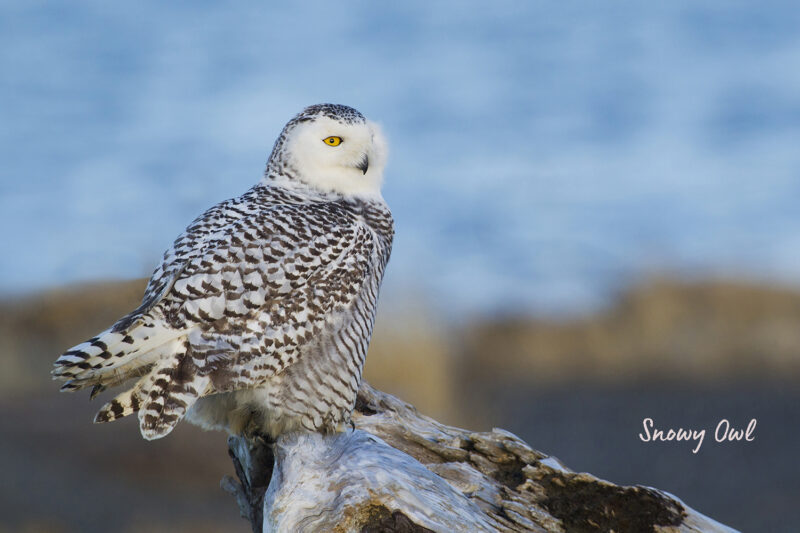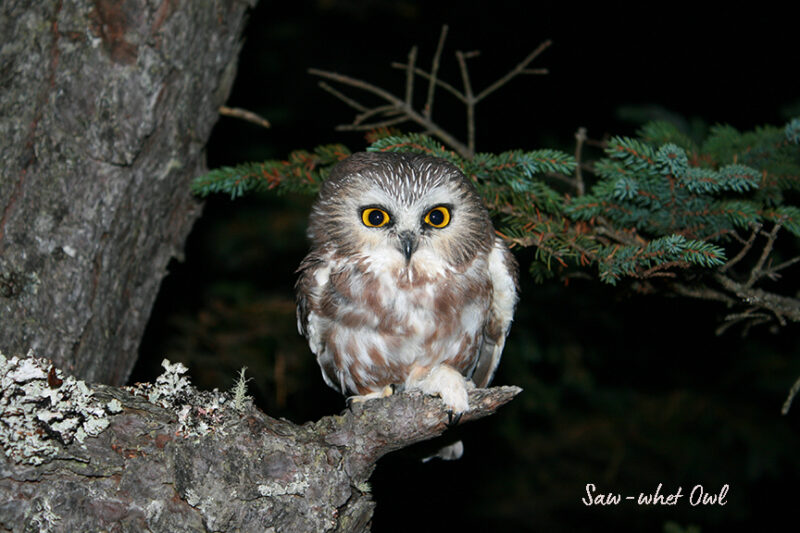


Author and field biologist Jeff Fair has followed loons, bears, and other wild spirits across the North from Maine to Alaska for more than 40 years, studying and writing about what his pursuit of them has allowed him to find.
Read Jeff’s previous articles here!
Encounters with Owls
The first owl I encountered as a young lad back in Palmdale, Pennsylvania, was the Great Horned Owl that haunted my grandparents’ attic. It had arrived there, likely from a tree near the chicken coop, by way of my grandfather’s 12-gauge and a taxidermist’s ministrations. Its musty silence I expected. What freaked me out was the way the black pupils of that dead, stiff, stuffed bird’s yellow marble eyes followed me wherever I walked within its gaze.

Snowy Owl
The second owl I ever saw was the Snowy Owl that my mother noticed sitting atop a telephone pole near our house in that same community during a winter irruption sometime in the late 1950s or early ’60s. It remained as silent and stoic as the owl in the attic, but when I crossed the street with binoculars, I could see its eyes following me.
My personal journey with owls has continued across the following half century, the observations occasional, mostly by surprise, always full of enjoyment. My interest in these birds was—and still is—more romance than research. I do not go out of my way to study owls, nor do I keep a bird list anymore. But I do like to learn the names and habits of the creatures I encounter at home and in my work. And so, I learned to identify many of the owls. Because I seem to hear a lot more owls than I see, identification required learning their peculiar voices. The first lesson in doing so is that not all owls are hoot owls.
Sure, there are the Barred Owls with their classic hooted “She cooks for me . . . Who cooks for you?” Or, as my ornithology professor professed from behind a sly grin, the more southerly of the species finish their song with “Who cooks for you-all”? Then there are the Great-Horned Owls, who air a similar tone but utter only four syllables, with a stutter on the second hoot. The Great Gray Owl offers a slow series of low hoots, more sad than haunting. The Short-eared Owl calls out a faster series of 10 or 12 whispery hoots. And the Long-eared Owl has a longer hoot every few seconds. Their individual tempos and pitches are all discernible.
The Snowy Owl sometimes emits low, scratchy hoots, but is better known for a variety of barks, clucks, whistles, and its lengthy territorial screams. Fortunately, one is likely to identify this owl by sight before hearing it—just prepare yourself for the screams. The Barn Owl suffices with a shorter, hoarse shriek that likely sent many a farm kid running for the house.

Saw-whet Owl
The “impersonators” are easier to discern. The Eastern Screech Owl whinnies like a pony. The tiny Saw-whet Owl sings the song of a commercial dump truck in reverse. I’m referring to the warning alarm that sounds on a constant beat when a commercial piece of equipment is backing up. The Saw-whet, by the way, is not named for the swish-strokes of a hand saw cutting through wood as some field guides suggest. It is named for the sound of the teeth of a crosscut saw being sharpened (whetted) with a whetstone—steady short strokes by the sawyer that made the old saws sing in the woods. This is the little owl that I watched flying in very tight circles around a wildlife researcher’s head one evening in the mountains of New Hampshire, in love (or territorial contention) with the regular, high-pitched chirp in my colleague’s headphones. Yagi antenna in hand, she was receiving the signal from the radio collar on a black bear a mile away. I couldn’t hear it, but the owl could.
The Boreal Owl sings somewhat higher, faster notes, sounding through a cabin window like a bearing going bad in your hard drive. And the Northern Hawk Owl nearly vibrates with the rapid staccato soprano of a loose fan belt.
Owls are complicated creatures, and they all have vocal repertoires larger than I have suggested. They hiss and screech, they growl and bark and squeak. Their young cry and beg with yet other voices. There are many strange sounds out there; if you’re not sure of one, well, never underestimate the inspiration of owls. For example, late one autumn night in southeastern Oklahoma, decades ago, I walked into the woods to sit with my father’s Winchester to watch for deer at dawn. I woke in the early morning light, and at my first movement a strident cacophony I’d never expected erupted from a few yards above me in the tree I’d used as a backrest. It sounded like the demented harangue of an enraged chimpanzee. An electric shock of fear ran through me. I looked up and saw a Barred Owl, still swearing at me while sidestepping out a branch and then flying off. A few minutes later I heard some rustling in the leaf litter. I squinted toward the noise and readied the rifle, but it was a flock of antlerless turkeys.
I mentioned the surprising noise to my friend Norm, a local, and he said, “Did it sound like this?” And he then produced an exact replica of the owl’s catastrophic scolding. I said, “How did you know that?” He replied, “Well, I’m a turkey hunter, and that call attracts turkeys.”
I’ve found myself being eyed by owls on other occasions. Once in grad school I was perched near a ruffed grouse’s drumming log, hoping to record his display. A bit of snow fell from a tree branch above me; when I looked up, a Barred Owl was staring back. And here in Alaska I was hunting in a heavy concentration of snowshoe hares. It was a November day with no snow; they moved about like white ghosts on the ground. I nearly walked into the yellow eyes of a Great Horned. In both cases, my quarry was also the owl’s.
It goes on like this, unplanned: In an open meadow I follow a meadow vole’s stitch-like perforations across the snow to where they end abruptly. At that point, two drops of blood are framed by the wispy traces of an owl’s primaries. In summer, beneath a nesting tree, I find a perfectly dry oval-shaped ball of hair and tiny bones—the regurgitated indigestibles in the form of an owl pellet—which an eager field biologist (such as myself) will dissect with a twig to ascertain the owl’s recent diet.

Short-eared Owl
Owls are often described as predators of the night, but this is not entirely so. On the Arctic tundra, come summer with its midnight sun, Snowy Owls and Short-eared Owls have no darkness for months. The snowies perch on pingos and polygons, scattered across the barren grounds like so many white fireplugs, watching for lemmings and voles. The short-ears tilt like harriers just above the cotton grass, trolling for similar prey.
Instead, I consider owls to be creatures of silence more than darkness. Silence provides the aural setting for hunting by ear, which is not confined to the night. I’ve watched a Barred Owl standing on a snow-covered meadow in daylight, intently focused on some faint subnivean rustle nearby, head periodically rotating just a few degrees between left and right for long minutes. Then suddenly, a quiet raising of wings, a single flap lifting the owl off the snow toward the hidden target, and a fast plunge, talons first, into the depths. And afterward, the liftoff with something brown and squirming in its grasp.
Owls fly on silent wings, quiet as moths, unlike the Goldeneye’s whistling wings or the shrill rasp of a raven’s wings cutting through gelid air. Soft plumage plays a role in this. In order to rescue an injured Barred Owl once, I threw my canvas shirt over it on the roadside gravel. The bulky owl disappeared as if in a magician’s act. Then I saw something the size of a squirrel wiggling underneath. The weight of my shirt had totally deflated that soft plumage. Most of an owl’s volume is silencer.
Here at my cabin in the Chugach Mountains, I enjoy sneaking out onto my porch in the late winter stillness to listen for the Great Horned Owls, or the sound of a dumptruck’s back-up alarm, the staccato screech of a failed bearing or a loose fan belt. Tonight—and I’ve waited for this—I hear a Great Horned again, out by the Grandfather Spruce not far from the cabin. “Whoo h’hooo hooo hoo . . .,” its call not breaking the precious silence so much as distilling it into voice.
Above me, Cygnus drops toward the western horizon. The Little Bear spins by her tail directly above my chimney. Down by the Grandfather Spruce the silence flows back, refilling its void.
Who will endeavor to conserve these quiet places in the face of burgeoning humanity? Who will watch over the owls and the other creatures who inhabit them? Who, indeed? Important considerations; nagging but necessary questions. I’ll ponder them tomorrow. For tonight, I am fulfilled, my one-sided romance requited, my connection reaffirmed. The hoot owl has called out her name, and that is enough.
Jeff Fair
Lazy Mountain, Alaska
This piece was first published as the foreword in the book Journey with the Owls by David Evers and Kate Taylor. 2015. Willow Creek Press.


